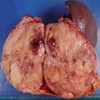VIP and Calcitonin-Producing Pancreatic Neuroendocrine Tumor with Watery Diarrhea: Clinicopathological Features and the Effect of Somatostatin Analogue
Abstract
Context Pancreatic neuroendocrine tumor (pNET) secretes various peptide hormones; however, calcitonin hypersecretion is rare. Its clinicopathological significance and treatment is still controversial. Case report A 43 year-old Japanese man presented severe watery diarrhea and a large mass in the pancreatic tail. Blood concentration of VIP was elevated to 649 pg/mL (reference range: 0-100 pg/mL), and calcitonin to 66,700 pg/mL (reference range: 15-86 pg/mL). There was no tumor in other endocrine organs. The resected tumor was composed of 80% calcitonin-positive cells and 10% VIP-positive cells. After the operation, the levels of VIP and calcitonin were decreased to 44 and 553 pg/mL, respectively, and diarrhea was improved. The mRNA of somatostatin receptor (SSTR) subtypes 2, 3 and 5 in the tumor tissue were increased 22.8, 25.1, and 37.0-fold of those of normal pancreas, respectively. At 19 months after the operation, blood calcitonin was again raised to 3,980 pg/mL, and metastatic tumors were found in the liver. With the treatment of long-acting somatostatin analogue, calcitonin was reduced to 803 pg/mL. The patient does not present endocrine symptom, and the size of the metastatic tumors appears stable. Conclusion From the world literature to date, co-secretion of VIP and calcitonin was documented in only 10 cases of pNET including the current case. Although VIP is a primary cause of diarrhea in these cases, high level of calcitonin may also influence on the clinical symptoms. Somatostatin analogue suppresses the levels of VIP and calcitonin, and the control proliferation is also expected when tumor cells express SSTRs.
Downloads
References
Rambaud JC, Modigliani R, Matuchansky C, Bloom S, Said S, Pessayre D, et al. Pancreatic cholera. Sudies on tumoral secretions and pathophysiology of diarrhea. Gastroenterology. 1975;69:110-122. [PMID 1097288]
Yamaguchi K, Abe K, Adachi I, Tanaka M, Ueda M, Oka Y, et al. Clinical and hormonal aspects of the watery diarrhea-hypokalemia-achlorhydria (WDHA) syndrome due to vasoactive intestinal polypeptide (VIP)-producing tumor. Endocrinol Jpn. 1980;27 Suppl 1:79-86. [PMID 7014208]
Crowley PF, Slavin JL, Rode J. Massive amyloid deposition in pancreatic vipoma: a case report. Pathology. 1996;28:377-379. [PMID 9007963]
Eskens FA, Roelofs EJ, Hermus AR, Verhagen CA. Pancreatic islet cell tumor producing vasoactive intestinal polypeptide and calcitonin. Anticancer Res. 1997;17:4667-4670. [PMID 9494586]
Ichimura T, Kondo S, Okushiba S, Morikawa T, Katoh H. A calcitonin and vasoactive intestinal peptide-producing pancreatic endocrine tumor associated with the WDHA syndrome. Int J Gastrointest Cancer. 2003;33:99-102. [PMID 14716055]
Mullerpatan PM, Joshi SR, Shah RC, Tampi CS, Doctor VM, Jagannath P, et al. Calcitonin-secreting tumor of the pancreas. Dig Surg. 2004;21:321-324. [PMID 15375334]
Jackson C, Buchman AL. Calcitonin-secreting VIPoma. Dig Dis Sci. 2005;50:2203-2206. [PMID 16416161]
Nasir A, Gardner NM, Strosberg J, Ahmad N, Choi J, Malafa MP, et al. Multimodality management of a polyfunctional pancreatic endocrine carcinoma with markedly elevated serum vasoactive intestinal polypeptide and calcitonin levels. Pancreas. 2008;36:309-313. [PMID 18362846]
Nakayama Y, Wada R, Yajima N, Hakamada K, Yagihashi S. Profiling of somatostatin receptor subtype expression by quantitative PCR and correlation with clinicopathological features in pancreatic endocrine tumors. Pancreas. 2010;39:1147-1154. [PMID 20717067]
Volante M, Brizzi MP, Faggiano A, La Rosa S, Rapa I, Ferrero A, et al. Somatostatin receptor type 2A immunohistochemistry in neuroendocrine tumors: a proposal of scoring system correlated with somatostatin receptor scintigraphy. Mod Pathol. 2007;20:1172-1182. [PMID 17873898]
Delis S, Bakoyiannis A, Giannakou N, Tsigka A, Avgerinos C, Dervenis C. Asymptomatic calcitonin-secreting tumor of the pancreas. A case report. JOP. 2006;7:70-73. [PMID 16407623]
Ebert EC. The thyroid and the gut. J Clin Gastroenterol. 2010;44:402-406. [PMID 20351569]
Gray TK, Bieberdorf FA, Fordtran JS. Thyrocalcitonin and the jejunal absorption of calcium, water, and electrolytes in normal subjects. J Clin Invest. 1973;52:3084-3088. [PMID 4750441]
Norton J, Wells S. Medullary thyroid carcinoma and multiple endocrine neoplasia type 2 syndromes. In: Friesen S, Thompson N, eds. Surgical endocrinology Clinical syndromes. 2nd ed. Philadelphia: Lippincott; 1990:359-375.
Guillermet-Guibert J, Lahlou H, Pyronnet S, Bousquet C, Susini C. Endocrine tumours of the gastrointestinal tract. Somatostatin receptors as tools for diagnosis and therapy: molecular aspects. Best Pract Res Clin Gastroenterol. 2005;19:535-551. [PMID 16183526]
Sharma K, Patel YC, Srikant CB. Subtype-selective induction of wild-type p53 and apoptosis, but not cell cycle arrest, by human somatostatin receptor 3. Mol Endocrinol. 1996;10:1688-1696. [PMID 8961277]
Sharma K, Patel YC, Srikant CB. C-terminal region of human somatostatin receptor 5 is required for induction of Rb and G1 cell cycle arrest. Mol Endocrinol. 1999;13:82-90. [PMID 9892014]
Rinke A, Müller HH, Schade-Brittinger C, Klose KJ, Barth P, Wied M, et al. Placebo-controlled, double-blind, prospective, randomized study on the effect of octreotide LAR in the control of tumor growth in patients with metastatic neuroendocrine midgut tumors: a report from the PROMID Study Group. J Clin Oncol. 2009;27:4656-4663. [PMID 19704057]

Copyright (c) 2014 Tomoya Kon, Ryuichi Wada, Ryuta Suzuki, Yoshihito Nakayama, Yoshihito Ebina, Soroku Yagihashi

This work is licensed under a Creative Commons Attribution 4.0 International License.
As a member of Publisher International Linking Association, PILA, iMedPub Group’s JOP follows the Creative Commons Attribution License and Scholars Open Access publishing policies. Journal of the Pancreas is the Council Contributor Member of Council of Science Editors (CSE) and following the CSE slogan Education, Ethics, and Evidence for Editors.